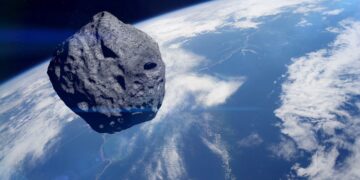Astronomers have recently detected a near-Earth asteroid, 2024 YR4, whose estimated probability of striking Earth has doubled—from 1% to 2.3%—since its initial discovery in December 2024. While such an increase may sound alarming, scientists remain cautious rather than panicked. This article dives into what we know about 2024 YR4, its potential impact, and the actions being taken to track and mitigate its risk.
What is Asteroid 2024 YR4?
Asteroid 2024 YR4 was discovered in late December 2024 and classified as a near-Earth object (NEO). The name follows the conventional designation system: ‘Y’ indicates its discovery in the latter half of December, ‘R4’ means it was the 117th asteroid found in the last two weeks of the year.
Upon its initial detection, astronomers calculated a 1% chance of impact with Earth on December 22, 2032. However, as more observations were made, new orbital simulations adjusted this risk to 2.3%—meaning that out of 1,000 possible future paths for the asteroid, 23 resulted in a collision with Earth.
Understanding the 2.3% Impact Risk
The 2.3% impact probability does not mean a direct collision is inevitable. Rather, it is a statistical projection based on current orbital data. The most likely scenario suggests that 2024 YR4 will make a close pass within 240,000 km of Earth, which is inside the Moon’s orbit but not dangerously close.
NASA’s Planetary Defense Coordination Office (PDCO) has assigned 2024 YR4 a Torino Scale 3 ranking, which means it warrants attention but is not an immediate threat. Typically, impact risks at Torino Scale 3 require continued monitoring but rarely remain a concern once further data is collected.
Why Early Orbit Predictions Are Uncertain
Asteroid orbits are influenced by many factors, making early calculations subject to revision. Unlike planets, which follow well-defined paths, asteroids are influenced by:
- Gravitational tugs from planets and other objects
- The Yarkovsky effect, where an asteroid’s own radiation emission alters its trajectory over time
- Close approaches to Earth, such as one expected in 2028, which will allow astronomers to refine their predictions
In 2028, 2024 YR4 will pass within 8 million km of Earth, a relatively close but safe distance. This encounter will provide a crucial opportunity to obtain more precise measurements of its orbit and determine whether further action is necessary.
Potential Impact Consequences
If 2024 YR4 were to strike Earth, what would happen?
- Its estimated diameter is between 40 and 90 meters, similar to the Tunguska event of 1908, which flattened 2,000 square kilometers of Siberian forest.
- The impact would not cause mass extinction, but could devastate a region the size of a city if it struck a populated area.
- If it landed in the ocean, it could generate tsunamis, though the actual risk depends on the impact angle and location.
Despite these possible consequences, 2024 YR4 is not large enough to pose a global threat.
What If an Impact Becomes More Likely?
If future observations confirm an increased probability of impact, what are our options?
- Deflection Strategies: Scientists could deploy the kinetic impactor technique, where a spacecraft is sent to collide with the asteroid to change its trajectory. NASA’s Double Asteroid Redirection Test (DART) successfully demonstrated this method in 2022.
- Gravity Tractors: A spacecraft could be placed near the asteroid to gradually alter its orbit using gravitational interaction.
- Nuclear Option: While not the preferred method, a nuclear explosion could be used as a last resort to deflect or fragment the asteroid. However, this carries risks of breaking the asteroid into smaller, harder-to-track pieces.
The Importance of Planetary Defense
Unlike unexpected asteroid events like Chelyabinsk (2013)—which caught astronomers off guard—2024 YR4 is being tracked years in advance. This means we have plenty of time to prepare and respond if necessary. The real danger from asteroids often comes from unknown objects that have not yet been discovered, not those like 2024 YR4, which we are actively monitoring.
NASA, ESA, and other international space agencies maintain planetary defense programs dedicated to tracking near-Earth objects and planning mitigation efforts.
What’s Next? Tracking and Future Observations
- 2025: The James Webb Space Telescope (JWST) and other observatories will conduct detailed studies of 2024 YR4 to refine its size, composition, and trajectory.
- 2028: Close pass at 8 million km will provide the best opportunity to confirm whether it remains a threat.
- 2032: Potential impact date (though the odds are expected to decrease significantly with more data).
Conclusion: No Need for Panic, But Continued Observation is Key
The discovery of asteroid 2024 YR4 and its updated impact probability have understandably drawn public attention. However, the current risk level remains low, and future observations are likely to reduce the impact probability even further.
The key takeaway? We have time, we have the technology, and we have a plan. Scientists around the world are working to ensure that if action is needed, we will be ready. Until then, astronomers will continue to track 2024 YR4, and the public should stay informed through official sources like NASA’s Planetary Defense Coordination Office.



















